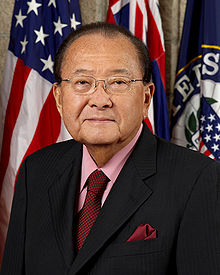Portal:Hawaii
The Hawaii Portal Hawaii (/həˈwaɪ.i/ ⓘ hə-WY-ee; Hawaiian: Hawaiʻi [həˈvɐjʔi, həˈwɐjʔi]) is an island state of the United States, in the Pacific Ocean about 2,000 miles (3,200 km) southwest of the U.S. mainland. It is the only state not on the North American mainland, the only state that is an archipelago, and the only state in the tropics. Hawaii consists of 137 volcanic islands that comprise almost the entire Hawaiian archipelago (the exception, which is outside the state, is Midway Atoll). Spanning 1,500 miles (2,400 km), the state is physiographically and ethnologically part of the Polynesian subregion of Oceania. Hawaii's ocean coastline is consequently the fourth-longest in the U.S., at about 750 miles (1,210 km). The eight main islands, from northwest to southeast, are Niʻihau, Kauaʻi, Oʻahu, Molokaʻi, Lānaʻi, Kahoʻolawe, Maui, and Hawaiʻi, after which the state is named; the latter is often called the "Big Island" or "Hawaii Island" to avoid confusion with the state or archipelago. The uninhabited Northwestern Hawaiian Islands make up most of the Papahānaumokuākea Marine National Monument, the largest protected area in the U.S. and the fourth-largest in the world. Of the 50 U.S. states, Hawaii is the eighth-smallest in land area and the 11th-least populous; but with 1.4 million residents, it ranks 13th in population density. Two-thirds of Hawaii residents live on O'ahu, home to the state's capital and largest city, Honolulu. Hawaii is among the country's most diverse states, owing to its central location in the Pacific and over two centuries of migration. As one of only six majority-minority states, it has the only Asian American plurality, the largest Buddhist community, and largest proportion of multiracial people in the U.S. Consequently, Hawaii is a unique melting pot of North American and East Asian cultures, in addition to its indigenous Hawaiian heritage. Settled by Polynesians sometime between 1000 and 1200 CE, Hawaii was home to numerous independent chiefdoms. In 1778, British explorer James Cook was the first known non-Polynesian to arrive at the archipelago; early British influence is reflected in the state flag, which bears a Union Jack. An influx of European and American explorers, traders, and whalers soon arrived, leading to the decimation of the once-isolated indigenous community through the introduction of diseases such as syphilis, tuberculosis, smallpox, and measles; the native Hawaiian population declined from between 300,000 and one million to less than 40,000 by 1890. Hawaii became a unified, internationally recognized kingdom in 1810, remaining independent until American and European businessmen overthrew the monarchy in 1893; this led to annexation by the U.S. in 1898. As a strategically valuable U.S. territory, Hawaii was attacked by Japan on December 7, 1941, which brought it global and historical significance, and contributed to America's entry into World War II. Hawaii is the most recent state to join the union, on August 21, 1959. In 1993, the U.S. government formally apologized for its role in the overthrow of Hawaii's government, which had spurred the Hawaiian sovereignty movement and has led to ongoing efforts to obtain redress for the indigenous population. (Full article...) This is a Featured article, which represents some of the best content on English Wikipedia..
On 9 February 2001, about nine nautical miles (17 km; 10 mi) south of Oahu, Hawaii, in the Pacific Ocean, the United States Navy (USN) Los Angeles-class submarine USS Greeneville (SSN-772) collided with the Japanese fishery high-school training ship Ehime Maru (えひめ
This is a Good article, an article that meets a core set of high editorial standards.
William Phileppus Ragsdale (c. 1837 – November 24, 1877) was a Hawaiian lawyer, newspaper editor, and translator. He was a popular figure known for being luna or superintendent of the Kalaupapa Leprosy Settlement. Elements of his life story influenced Mark Twain's 1889 novel A Connecticut Yankee in King Arthur's Court. (Full article...) Selected Picture - 'Ōlelo (Language) -This section is here to highlight some of the most common words of the Hawaiian Language, ʻŌlelo, that are used in everyday conversation amongst locals.
Aloha
Love, hello, goodbye Aloha kakahiaka, Good morning; Aloha ahiahi, Good evening; Aloha Akua, Love of God State Facts
State Symbols:
Selected article -Daniel Ken Inouye (/iːˈnoʊˌeɪ/ ee-NOH-ay; September 7, 1924 – December 17, 2012) was an American attorney, soldier, and politician who served as a United States senator from Hawaii from 1963 until his death in 2012. Beginning in 1959, he was the first U.S. Representative for the State of Hawaii, and a Medal of Honor recipient. A member of the Democratic Party, he also served as the president pro tempore of the United States Senate from 2010 until his death. Inouye was the highest-ranking Asian-American politician in U.S. history until Kamala Harris became vice president in 2021. Inouye also chaired various senate committees, including those on Intelligence, Indian Affairs, Commerce, and Appropriations. Inouye fought in World War II as part of the 442nd Infantry Regiment. He lost his right arm to a grenade wound and received several military decorations, including the Medal of Honor (the nation's highest military award). He later earned a J.D. degree from George Washington University Law School. Returning to Hawaii, Inouye was elected to Hawaii's territorial House of Representatives in 1953, and was elected to the territorial Senate in 1957. When Hawaii achieved statehood in 1959, Inouye was elected as its first member of the House of Representatives. He was first elected to the U.S. Senate in 1962. He never lost an election in 58 years as an elected official, and he exercised an exceptionally large influence on Hawaii politics. (Full article...)Did you know? -
Hawaii News
Wikinews Hawaii portal
Quotes - "E naʻi wale nō ʻoukou, i kuʻu pono ʻaʻole pau" — King Kamehameha I On this day...There are no anniversaries listed for this day. Related portalsTopicsCategoriesAssociated WikimediaThe following Wikimedia Foundation sister projects provide more on this subject:
SourcesDiscover Wikipedia using portals |

























